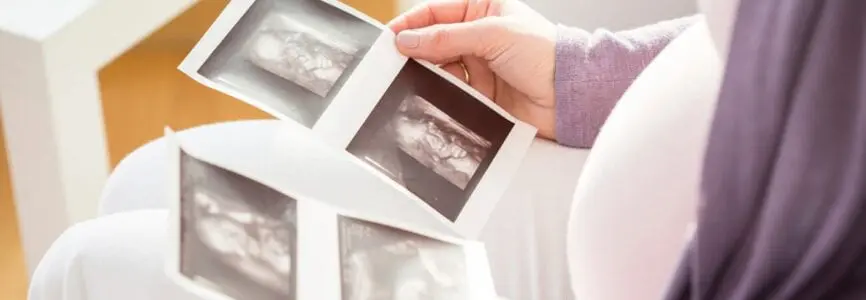Bioethics Forum Essay
With Legal Challenges to Abortion, Whither Prenatal Diagnosis?
Changes in abortion law threaten to undermine a major benefit of prenatal diagnosis, namely the ability of pregnant women to choose whether or not to continue their pregnancies upon learning of a serious fetal condition. The capacity to assess the health of the fetus has grown exponentially in the last 50 years, from blurry pictures on ultrasound, imprecise maternal blood tests, and amniocentesis in the second trimester, which carried a small but real risk of inducing miscarriage, to an incredibly sophisticated array of technologies, including real-time imaging and the use of noninvasive prenatal testing in about the third month to look for chromosomal conditions such as Down syndrome.
These tests, which have never been able to detect more fetal conditions with such a high degree of accuracy, are widely advertised, and packaging fetal ultrasound as “baby’s first picture” is common. It is important to realize that large segments of the population do not have access to these tests either because they are not covered by insurance or because some doctors refuse to provide them. When these tests are used, most of the results are reassuring, but sometimes serious problems are detected.
While diagnostic tools have increased, prenatal therapies have lagged far behind, with very few conditions amenable to fetal intervention. Thus, women who learn that the fetus they are carrying has a serious disorder typically have only two choices. They can continue the pregnancy. In some cases, delivery at a high-risk hospital can improve the child’s outcome. But prior knowledge is not necessarily benign, as it can also cause parental stress and anxiety that can continue well after the child is born, rather than leading seamlessly to preparation and acceptance.
The other option following a diagnosis of a serious condition is terminating the pregnancy, an option first legalized in the early days of prenatal diagnosis and that is now under assault from many directions. Legislators in many states are putting increasingly onerous barriers to abortion in place. Two trends are particularly noteworthy. One of them is to permit abortion, if at all, only very early in pregnancy, often before women know they are pregnant and, hence, well before they have prenatal diagnosis. The other, more pointed, trend, is to deter abortions motivated by sex or race or the presence of fetal anomalies—so-called “reason-based” abortions—often by imposing felony penalties on abortion providers. Such laws have been enacted by more than 10 states and are being considered by many more. These statutes, some of which identify only Down syndrome as a proscribed reason for terminating a pregnancy following a prenatal diagnosis, typically cite among other things desire to avoid discrimination.
The assertion that prenatal diagnosis causes individuals with Down syndrome to be victims of discrimination, however, is misguided. Fifty years ago, it was not uncommon for children with Down syndrome to be placed in institutions at the advice of physicians, surgical problems were not repaired, and their life span was just over 10 years of age. Today, the picture could hardly be more different. Children who are born with Down syndrome typically live at home, receive needed medical care, go to school, in some cases including college, often have paid employment, and have life spans into the 50s and beyond. And improved care is afforded to all children with congenital disorders, genetic or otherwise, not just those with Down syndrome. This trajectory clearly reflects the laudable evolution of public policy in the United States, but it also reflects the choice of many prospective parents to proceed with their pregnancies after receiving a prenatal diagnosis.
Despite improved care and support for children with disabilities, Justice Clarence Thomas argued in his 2019 Supreme Court opinion in Box v. Planned Parenthood that abortion following prenatal diagnosis is “modern-day eugenics.” Relying on Justice Thomas’s analysis, the Sixth Circuit Court of Appeals has permitted Ohio’s and Tennessee’s “reason-based” bans to remain in effect pending litigation. The Supreme Court has just demonstrated its willingness to address a direct challenge to existing abortion jurisprudence by agreeing to review Dobbs v. Jackson Women’s Health Organization, a case challenging Mississippi’s ban on abortion after 15 weeks. How the Court will decide Dobbs remains to be seen, but it is not hard to imagine that the Court could then take up the question of whether women have the right to elect abortion after prenatal diagnosis since the circuits do not agree on whether efforts to limit these procedures are constitutionally permissible.
If the Supreme Court ultimately upholds states’ efforts to limit abortion following prenatal diagnosis or before prenatal diagnosis is even possible, what role will prenatal diagnosis be left to play? Certainly, the value of prenatal diagnosis to women and their families will be severely curtailed if, upon the detection of a serious fetal condition, they lose their hope for a healthy baby and are left with waiting for a known but uncertain and unseen outcome.
Ellen Wright Clayton, MD, JD, is the Craig Weaver Professor of Pediatrics and Professor of Health Policy at the Center for Biomedical Ethics and Society at Vanderbilt University Medical Center and a professor at Vanderbilt University Law School. Clayton is a Hastings Center fellow. @genomemom













